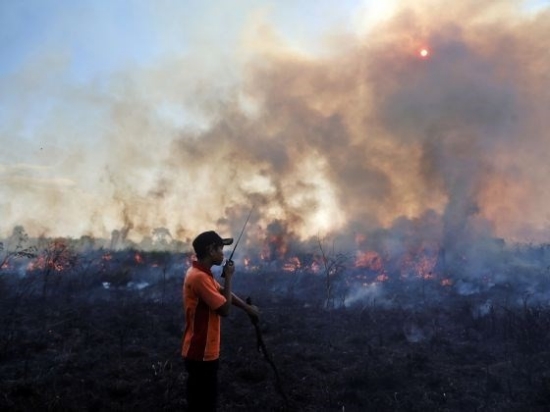29 Jun 2016

PUBLISHED: 2:40 PM, JUNE 29, 2016
UPDATED: 4:09 PM, JUNE 29, 2016
JAKARTA — Forest fires that blanketed South-east Asia in thick haze last year released the greatest amount of climate-changing carbon since record blazes in 1997, producing emissions higher than in the whole of the European Union, scientists said on Tuesday (June 29).
Singapore, Malaysia and northern Indonesia choked under a layer of toxic smog in September and October last year, caused by thousands of fires started in Indonesia to cheaply clear land for palm oil crops and for pulp and paper plantations.
The fires and resulting haze, an annual occurrence, pushed up pollution levels, caused schools to close, flights to be disrupted and people to fall sick across the region.
Last year’s blazes were the worst for years with El Nino, a warming of sea-surface temperatures in the Pacific, causing tinder-dry conditions.
The study by scientists from the Netherlands, Britain and Indonesia, published in the online journal Scientific Reports recently, was the first scientific report calculating greenhouse gas emissions from the fires using measurements on the ground combined with satellite observations.
“There have been some isolated studies before where people artificially set fires in the lab to try to understand the chemical characteristics of peatland fire smoke in Indonesia,” said Mr Martin Wooster, one of the scientists and a professor of earth observation science at King’s College London.
“But no one had done this on natural fires, and especially not on the kind of extreme fires seen in 2015,” he added.
The researchers first measured the ground-level smoke composition from peatland burning in the region, including in Indonesia’s Central Kalimantan province, one of the worst-hit areas.
They combined the data with satellite information to work out greenhouse gas emission estimates from the fires.
They concluded that 884 million tonnes of carbon dioxide was emitted in the region last year, with 97 per cent originating from forest fires in Indonesia.
The results showed that regional carbon dioxide emissions from the fires were 11.3 million tonnes per day in September and October 2015, more than the 28-nation EU’s daily emissions of 8.9 million tonnes during the same period.
The researchers also said the emissions were worse than during the 1997 fires, considered the worst on record.
At that time, there was an even longer drought and widespread burning due to a stronger El Nino.
The researchers said they hoped the findings would contribute to a better understanding on the need for fire prevention and improved ways of managing the land.
“What is important is the applicability of a study like this in helping policy makers to use more accurate fire emission factors to design policy and act to prevent further fires and greenhouse gas emissions,” said scientist Daniel Murdiyarso from the Indonesia-based Centre for International Forestry Research.
The Indonesian fires have prompted criticism from green groups and other South-east Asian nations, accusing Jakarta of not doing enough to crack down on the slash-and-burn forest clearing techniques.
In a bid to tackle the issue, President Joko Widodo announced in April plans for a moratorium on new palm oil concessions and asked firms to raise yields on existing plantations instead of clearing forests. REUTERS